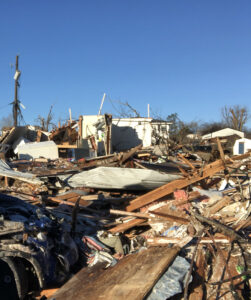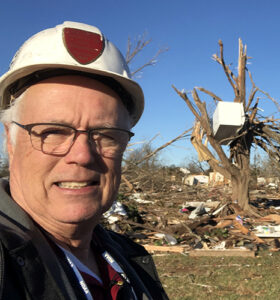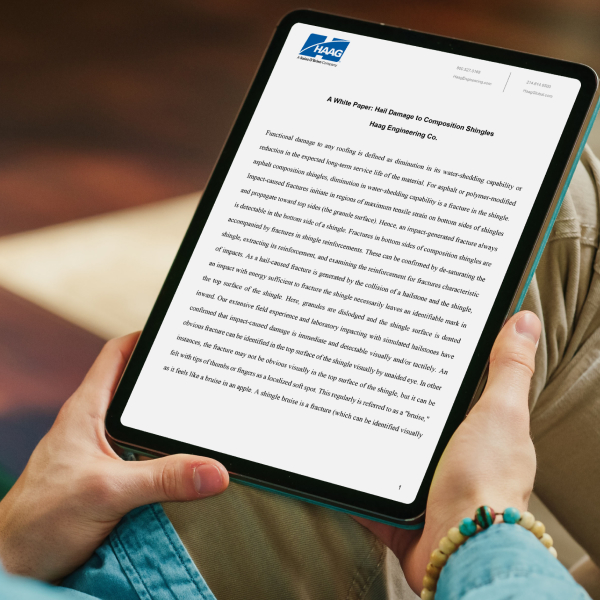AN UPDATE TO THE ENHANCED FUJITA SCALE
by Tim Marshall, P.E., Principal Engineer Emertitus, Meteorologist 
Dr. Ted (Tetsuya) Fujita created a tornado damage scale in 1970 after the Lubbock, Texas tornado. The damage scale was divided into six categories where F0 corresponded with minor damage to houses with estimated winds of 40 – 72 mph (18 – 32 m/s) all the way up to F5 where strong frame houses were swept off their foundations in estimated winds of 261 – 318 mph (117 – 142 m/s). Dr. Fujita determined the failure wind speeds based on dividing the gap between the Beaufort Scale (which mariners use) and the Mach Scale (which aviators use) into 12 non-linear increments.
In the early 2000’s, wind engineering studies showed mounting evidence that wood-framed houses can be completely destroyed at wind speeds less than 261 mph (117 m/s). Therefore, in 2001, the Wind Science and Engineering Center at Texas Tech University assembled a team of atmospheric scientists and wind engineers and developed the Enhanced Fujita (EF) Scale to address the inconsistencies of the F-Scale. I was selected along with five other scientists to estimate failure wind speeds to various building types.
In 2007, the National Weather Service (NWS) adopted the EF Scale and began utilizing the recently published EF Scale document to evaluate building damage. A copy of the EF Scale document can be found online at: https://www.spc.noaa.gov/faq/tornado/ef-ttu.pdf. This document includes degrees of damage (DODs) to 28 Damage Indicators (DIs) and was much more complex and accurate than the original F Scale. However, concerns remained about the relationships between the observed DoDs and wind speed ranges. Some DIs had limited guidance available. Users of the original EF Scale asked for new DIs to be created, especially in rural areas where building DIs are not common. More recently, alternative methods of estimating wind speeds have been published, including mobile Doppler radar measurements, tree-fall pattern analysis, and failure analysis of engineered structures. None of these methods had been included in the process of estimating tornado wind speeds. As a result, there have been awkward adjustments in tornado intensity by the NWS, including El Reno, OK and Bennington, KS in 2013. Additionally, recent research comparing wind speeds estimated from mobile Doppler radar measurements to speeds estimated from damage using the original EF Scale demonstrated an alarming trend, whereby wind speeds in approximately 40% of tornadoes were underestimated by two EF numbers. This means wind speeds for many tornadoes may be on the order of 50 mph greater than is currently being estimated and recorded in the national tornado database using the 2006 EF Scale (which is the dataset that serves as the basis for all tornado hazard maps).
In 2014, the American Society of Civil Engineers (ASCE)/Structural Engineering Institute (SEI) and the American Meteorological Society (AMS) undertook an effort to develop a consensus standard for tornado wind speed estimation. The forthcoming ASCE/SEI/AMS standard, Wind Speed Estimation in Tornadoes, will officially standardize the EF Scale. The committee undertaking this effort is organized into seven subcommittees, which were established to upgrade the EF Scale and develop methodologies to use treefall patterns, radar measurements, in-situ measurements, remote-sensing data and forensic engineering to estimate wind speeds. Requirements for archival of data will also be included in the standard. Both myself and Dr. Christine Alfano, P.E./CCM with Haag serve on this committee.
Updates to Version 2 of the EF Scale include developing new DIs, such as center pivot irrigation systems, religious buildings, passenger vehicles, and wind turbines, as well as redefining existing ones using knowledge gained from more than two additional decades of conducting damage evaluations using the original EF Scale. Additional updates included combining single- and double-wide manufactured homes into a single DI, creating separate DIs for wood-frame and concrete residences, recategorizing schools as single- or multi-story, and revamping the hardwood and softwood tree DIs to focus on single or multiple trees instead. Wind resistance levels have also been defined to aid in estimating the wind speed associated with specific visible damage. Where new research exists from laboratory, modeling, or other sources of data, wind speeds for specific damage states are also being updated. Updates also include improvements and standardization of the DoDs and associated wind speeds across DIs, and standardization of a procedure for the use of the EF Scale method. Representative damage photographs to serve as guidance, as well as a commentary with references, have been added to each DI. Many of these damage photographs comes from damage surveys that I conducted. However, the range of wind speeds that fall within each EF Scale category are not anticipated to change.
More than 80 scientists from various disciplines have volunteered their time to develop this standard. Thousands of hours have been put into this effort, and it is anticipated the standard will be published within the decade. Public input will be requested once the draft standard has completed the committee balloting process. It is anticipated the new standard will be issued within the next few years. Stay tuned to this blog for future updates.
By Tim Marshall, P.E., Meteorologist, Haag Principal Engineer

Tim Marshall is a structural engineer and meteorologist. He has served as a Haag Engineer since 1983, assessing damage to thousands of structures (particularly damage caused by wind and other weather phenomena). He has written numerous articles, presented countless lectures, and appeared on dozens of television programs in order to share his extensive knowledge re: storms and the resultant damage. He is a primary author of many Haag Education materials, including the Haag Certified Inspector-Wind Damage course. Mr. Marshall a pioneering storm chaser and was editor of Storm Track magazine. See his profile here.
Any opinions expressed herein are those of the author(s) and do not necessarily reflect those of Haag Global, Inc., Haag Canada, or any Haag companies.

